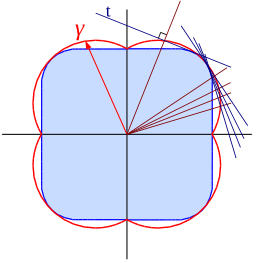 |
| A Wulff plot (the surface energies are given in red) Drawing by Michael Schmid and used under the GNU Free Documentation License |
| Image of a projection from Wulff's 1902 paper |
He published two important papers in 1901 and 1902 regarding crystal structures and stereographic projections. They are both in German, so I don't know exactly what they are getting at. Hammond says that Wulff proposed the Wulff net in 1909, but there seems to be an image of part of a Wulff net in his 1902 paper. His 1901 paper introduced the principles of the Wulff construction, which is a graphical method for determining the faces of a crystal that are expressed based on the surface energy of the different crystallographic directions. This idea built on Josiah Gibbs' proposal that materials want to minimize total surface energy. Wulff himself did not prove mathematically why his construction worked, but it was proved by Conyers Herring (1914-2009) in the 1950s.
| Crystal diagram from Wulff's 1901 paper |
Wulff was also in communication with William Henry Bragg and his son, William Lawrence Bragg, English crystallographers. Wulff derived an equation for x-ray diffraction in 1913 that was equivalent to the one proposed the year before by the Braggs, and so some people at the time called what is now known as Braggs' Law the Bragg-Wulff Law. Wulff appears to have lost out on the name because he published second, and, more importantly, he did not follow up with as many advancements on the topic as the Braggs. After that, he appears not to have taken on any new areas of study and faded into obscurity, though not without leaving his name for students of thermodynamics and crystallography to stumble upon.
Works
- G. Wulff, "Zur Frage der Geschwindigkeit des Waschsthums und der Auflösung der Krystallflächen," Zeitschrift für Krystallographie und Mineralogie 34 (1901) 449-530.
- G. Wulff, "Untersuchungen im Gebiete der optischen Eigenschaften isomorpher Krystalle," Zeitschrift für Krzstallographie und Mineralogie 36 (1902) 1-18.
- G. Wulff, "Über die Kristallröntgenogramme", Physikalische Zeitschrift 14 (March 15, 1913), 217-220.
- Correspondence with the Braggs, held at the National Archives in the UK.
References
- V. A. Frank-Kamenetsky, "Wulff, Georg (Yuri Viktorovich)." Complete Dictionary of Scientific Biography. 2008. Retrieved May 03, 2013 from Encyclopedia.com.
- Christopher Hammond, The Basics of Crystallography and Diffraction, 3rd edition. Oxford University Press, 2009.
- John C. Haff, "Use of the Wulff Net in Mineral Determination with the Universal Stage", American Minerologist 24 (1940) 689-707. A nice description of how to use a Wulff net, with illustrations.
- Conyers Herring, "Some Theorems on the Free Energies of Crystal Surfaces", Physical Review 82 (April 1, 1951), 87-93. This may be the paper that proves the Wulff construction, but the date differs from that on the Wikipedia page (1953). In this paper Herring mentions that others have proven that other methods give larger surface energies than Wulff, but does not say that any prior work has proven the Wulff construction, nor without more knowledge of the subject, can I say whether this proves it or not.
Well this is about the coolest thing ever. You should keep this blog going!
ReplyDeleteKen